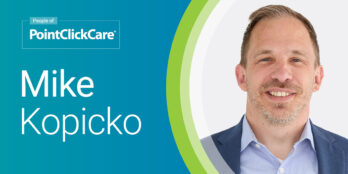
Your Vibe Attracts Your Tribe: Senior Living Staffing for Success
 4 min
4 min
People are more than your greatest asset; they are also your competitive edge. So how do you attract and retain the team that will set the vibe for your tribe? Right now senior living companies have to attract a multitude of new employees to the industry in order to fuel the growing demand. And it is growing!
National senior living association Argentum recently revealed that in order for the industry to keep up with an unprecedented influx of American seniors, it will have to attract more than 1.2 million more workers by the year 2025.
Where do you begin?
To help you get started, we asked Murry Mercier, PointClickCare’s Senior Living Account Manager, who has more than a decade of experience running senior living facilities, what some of the best staffing strategies are for senior living organizations.
Engage, Engage, Engage!
“When it comes to staffing strategies for senior living, my number one tip is to make sure that you’re engaging the staff that you already have,” Mercier says. “From there, only good things will come — but you have to make sure you’re engaging staff correctly.”
Staff engagement, in part, involves giving frontline staff the opportunity to take part in all levels of decision-making within a senior living community, Mercier explains. When frontline staff members have a voice, they feel empowered, as well as valuable to the company.
“Eliminating the sense of a top-down leadership experience can be really powerful,” Mercier says. “People feel motivated when they feel like they’re a part of something, rather than a cog in a wheel.”
To accomplish that, you should make sure information is traveling both ways — creating a sense of shared responsibility, while enabling leadership to better understand and play to the different staff members’ strengths. A strong team sends a positive vibe through your community, felt by your residents and visitors alike.
Similarly, staff should feel that the leadership knows what’s going on in the community, rather than being disconnected from the day-to-day realities. Leaders should also never be “above” a job.
“What I have seen in my own career is that a successful leader in senior living knows there is nothing they wouldn’t ask of their staff, that they wouldn’t be prepared to do themselves,” Mercier says.
And remember, staff engagement is never a one-time thing.
“Staff engagement is ongoing,” Mercier says. “It’s something we can always work on.”
Educate and Train Staff Properly
Make sure you’re providing your staff with further opportunities for education, Mercier says. Care delivery and the needs of your residents are constantly evolving and so it is important that your employees are at the front of these changes, learning beyond the skills required in their roles into areas that tap into personal interest that appeal to them such as memory care or physical care.
“This education allows them to become better at care partnering,” Mercier says. Additionally, you should make sure your community’s onboarding process is thorough and productive.
“Each one should teach one. If the staff feel well trained, they feel better prepared to do their jobs well,” Mercier says. And confident, valued staff members are less likely to look for other job opportunities outside the organization.
Invest in Tools for Success
“Having the right technology in place is going to help attract quality care partners and retain quality staff,” Mercier says.
“The right technology gives senior living staff ownership of the work they’re doing, and it saves staff members valuable time,” Mercier states.
Employees want to know if the documentation they’re doing is meaningful, who will be looking at their work, and whether the documentation is driving the future care of residents.
Staff members also want the ability to quickly communicate changes in a resident’s condition. Staff should have access to a resident’s care plan immediately, as well as their personal desires and backstory — everything that will make a staff member’s interaction with a resident a great experience for both. With the devil in the details, it is the small things that make a huge difference for great customer experience.
Implementing a technology solution that holds all resident information, such as an electronic health record platform, can greatly empower your workforce by providing the information they need — when they need it. Empowering the team with a single source of truth for all those in your care.
So, there you have it — three tips from a senior living expert on how to do staffing right. “Be sure to keep in mind that satisfied staff members are the best resources communities have to attract new employees,” Mercier says. Follow these tips and you’ll not only have happy employees — you’ll have prospective employees banging at your door.
To learn more about the importance of employee engagement, read our interview with Jan and Neil Gulsvig from Align on Why Turnover has Become Unacceptable in Long-Term Care.
Looking for more information on embracing technology in senior care? Check out the surprising survey results captured in Competition is Fierce: Embracing Technology for Successful Retention and Recruitment.
July 12, 2016






